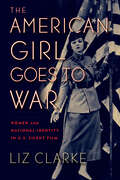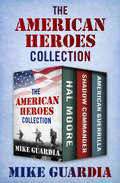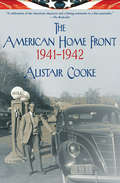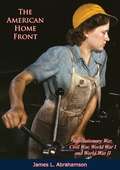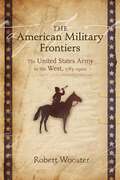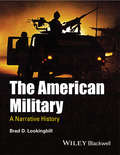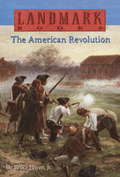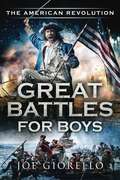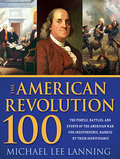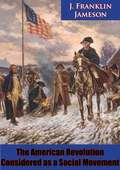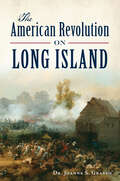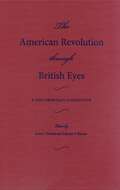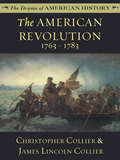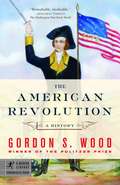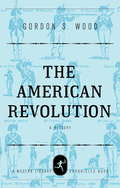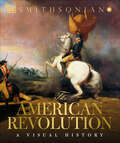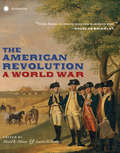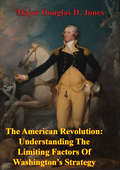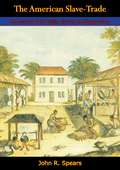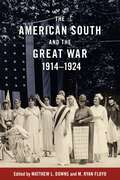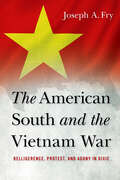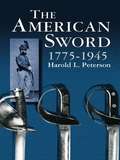- Table View
- List View
The American Girl Goes to War: Women and National Identity in U.S. Silent Film (War Culture)
by Liz ClarkeDuring the 1910s, films about war often featured a female protagonist. The films portrayed women as spies, cross-dressing soldiers, and athletic defenders of their homes—roles typically reserved for men and that contradicted gendered-expectations of home-front women waiting for their husbands, sons, and brothers to return from battle. The representation of American martial spirit—particularly in the form of heroines—has a rich history in film in the years just prior to the American entry into World War I. The American Girl Goes to War demonstrates the predominance of heroic female characters in in early narrative films about war from 1908 to 1919. American Girls were filled with the military spirit of their forefathers and became one of the major ways that American women’s changing political involvement, independence, and active natures were contained by and subsumed into pre-existing American ideologies.
The American Heroes Collection: Hal Moore, Shadow Commander, and American Guerrilla
by Mike GuardiaThree stirring military portraits—including a biography of the Vietnam War hero who wrote the New York Times bestseller, We Were Soldiers Once . . . and Young. Hal Moore: A heroic commander in the Vietnam War, Harold G. Moore cowrote the New York Times–bestselling memoir of the battle at Ia Drang and was portrayed by Mel Gibson in the film We Were Soldiers. This &“outstanding&” and definitive biography expands on the account of that pivotal battle to encompass Moore&’s distinguished military career from the Korean War through his courageous and invaluable service in Vietnam (Armchair General). Shadow Commander: In World War II, US Army legend Donald Blackburn escaped from Bataan along with Russell W. Volckmann and organized the guerrilla fighters known as &“Blackburn&’s Headhunters&” against the Japanese. He would go on to play a key role in the Vietnam War, revitalizing Army Special Forces operations in Southeast Asia, spearheading Operation White Star in Laos, and eventually taking command of the highly classified Studies and Observations Group (SOG). Blackburn was also the architect of the infamous Son Tay Prison Raid, officially termed Operation Ivory Coast, the largest prisoner-of-war rescue mission of the Vietnam War. &“A follow-up to a fine bio of Russell Volckmann, this tale of guerrilla warfare spans from Bataan to Vietnam.&” —World War II Magazine American Guerrilla: Here is Russell Volckmann&’s own story, from his refusal to surrender at Bataan to raising a Filipino army of more than twenty-two thousand men and leading a guerrilla war against the Japanese for the next three years. When General Yamashita finally surrendered, he made his initial overtures not to General Douglas MacArthur, but to Volckmann. The progenitor of modern counterinsurgency doctrine, Volkmann wrote the field manuals that became the US Army&’s first handbooks outlining the precepts for both special warfare and counter-guerrilla operations, making him the true &“father&” of Army Special Forces. &“[Volckmann&’s private army] waged arguably the most successful guerrilla campaign of the entire war . . . Mr. Guardia argues, convincingly, that Volckmann deserves the title of &‘father&’ of Special Forces.&” —The Washington Times
The American Home Front, 1941–1942: 1941-1942
by Alistair CookeIn nearly three thousand BBC broadcasts over fifty-eight years, Alistair Cooke reported on America, illuminating our country for a global audience. He was one of the most widely read and widely heard chroniclers of America-the Twentieth Century’s de Tocqueville. Cooke died in 2004, but shortly before he passed away a long-forgotten manuscript resurfaced in a closet in his New York apartment. It was a travelogue of America during the early days of World War II that had sat there for sixty years. Published to stellar reviews in 2006, though "somewhat past deadline,” Cooke’s The American Home Front is a "valentine to his adopted country by someone who loved it as well as anyone and knew it better than most” (The Plain Dealer [Cleveland]). It is a unique artifact and a historical gem, "an unexpected and welcome discover in a time capsule.” (Washington Post) A portrait frozen in time, the book offers a charming look at the war through small towns, big cities, and the American landscape as they once were. The American Home Front is also a brilliant piece of reportage, a historical gem that "affirms Cooke’s enduring place as a great twentieth-century reporter” (American Heritage).
The American Home Front: Revolutionary War, Civil War, World War I and World War II
by James L. AbrahamsonThis latest National Defense University military history seeks to broaden the perspective of those who are interested in understanding the effects of the wartime mobilization of American society. Through a comparative analysis of the economic, political, and social results of America's four principal wars, this study reveals the major issues faced by each wartime administration and sketches the consequences of the mobilization policies adopted. As the author, Colonel James L. Abrahamson, U.S. Army, explains, each conflict occurred in unique circumstances, required varied policies, and produced different effects on American institutions. He therefore avoids offering a simplistic list of the expected domestic consequences of any future conflict. Nevertheless, certain common factors, which may inform modern mobilization planners, surface in his analysis of these four wars. The author suggests that if planners are aware of the implications of their mobilization choices, they can better devise effective policies for drawing forth the material and human essentials of victory.
The American Journey: A History of the United States (AP Edition, Fourth Edition)
by David Goldfield Carl Abbott Virginia Dejohn Anderson Jo Ann E. Argersinger Peter H. Argersinger William L. Barney Robert M. WeirAmerican history is a compelling story and this book seeks to tell it in an engaging, forthright way. It also provides students with an abundance of tools to help them absorb that story and put it in context. It introduces them to the concerns of the participants in America's history with primary source documents.
The American Military Frontiers: The United States Army in the West, 1783-1900 (Histories of the American Frontier Series)
by Robert WoosterAs the fledgling nation looked west to the land beyond the Appalachian Mountains, it turned to the army to advance and defend its national interests. Clashing with Spain, Britain, France, Mexico, the Confederacy, and Indians in this pursuit of expansion, the army's failures and successes alternately delayed and hastened western migration. Roads, river improvements, and railroads, often constructed or facilitated by the army, further solidified the nation's presence as it reached the Pacific Ocean and expanded north and south to the borders of Canada and Mexico. Western military experiences thus illustrate the dual role played by the United States Army in insuring national security and fostering national development.Robert Wooster's study examines the fundamental importance of military affairs to social, economic, and political life throughout the borderlands and western frontiers. Integrating the work of other military historians as well as tapping into a broad array of primary materials, Wooster offers a multifaceted narrative that will shape our understanding of the frontier military experience, its relationship with broader concerns of national politics, and its connection to major themes and events in American history.
The American Military: A Narrative History
by Brad D. LookingbillThe American Military: A Narrative History presents a comprehensive introduction to more than four centuries of American military history. Presents a chronological account of American military history from clashes between militias and Native Americans to 21st-century operations in Afghanistan and Iraq Features personal vignettes to put a human face on armed conflict Addresses patterns of national service, the evolution of civil-military relations, and the advent of all-volunteer forces Puts events in historical context, and considers cultural, social, political, economic, and technological developments
The American Revolution
by Bruce Bliven Jr.Based on Greenhaven Press's critically acclaimed Opposing Viewpoints series, Opposing Viewpoints in World History is a critical thinking resource for the study of world history. Each anthology explores a divisive issue of history through primary and secondary documents arranged in a pro/con format. While prominent speakers of the past debate the important issues of the time, historians and other commentators continue the discussion by highlighting issues that are still debated today. The point/counterpoint structure challenges readers to exercise and sharpen their critical thinking skills while highlighting the most important issues throughout history. Introductions and chapter prefaces provide context, and bibliographies, indexes, and annotated tables of contents offer tools for further research. With its many useful features, the Opposing Viewpoints in World History series is a unique resource for examining complex historical topics. Book jacket.
The American Revolution (Great Battles For Boys)
by Joe GiorelloFrom Concord and Lexington to Brandywine and Yorktown, the stunning battles show young readers how ragtag colonists took on the world’s mightiest military of its time — the British Imperial Army, otherwise known as the Red Coats. <p><p> History leaps off the page and captures even reluctant readers as early colonial protests, such as the Boston Tea Party, bring even more tyranny from King George III. With a declaration of war from England and the appointment of George Washington as commander of the Continental Army, the revolution’s real battles begin. <p><p> In chronological order, Great Battles for Boys: The American Revolution takes young readers to the front lines of the war's major clashes such as: Long Island: British General Howe crushes Washington’s forces and proves the odds are against the Patriot forces.
The American Revolution 100: The Battles, People, and Events of the American War for Independence, Ranked by Their Significance
by Michael LanningExperience the defining moments of the war that gave birth to America. The American Revolution 100 brings to life the monumental moments, bloody battles, and influential leaders who gave birth to a great nation. In comprehensive fashion, decorated veteran and military expert Michael Lee Lanning ranks and analyzes the war's most significant events, showing how each affected the outcome. Relive the memorable battles, when a country of citizen-farmers prepared themselves to take on the mightiest army in the world. Learn about the remarkable figures and forces of the time, and decide for yourself: Who influenced the revolution more--John Adams, Benjamin Franklin, or John Paul Jones? Was the Battle of Yorktown more pivotal than the Battle of Trenton? Was The Declaration of Independence more important to the revolution than Thomas Paine's Common Sense? Read the stories of Henry Knox, Thomas Sumter, American militias, and December 26, 1776, and let your own debates begin... Praise for Michael Lee Lanning's history books: "Easily accessible... Recommended reference for the aficionado and the uninitiated alike." ForeWord magazine. "Unusual and even witty insights also abound." Publishers Weekly.
The American Revolution Considered as a Social Movement
by J. Franklin JamesonThis small book, first published in 1926, is comprised of three lectures on the American Revolution considered as a Social Movement, which were delivered by renowned historian and author J. Franklin Jameson in November 1925 on the Louis Clark Vanuxem foundation. In the fourth and final chapter, Jameson sums up and provides thoughts in conclusion.Proving to be an influential publication, the book expresses themes that Jameson had been developing since the 1890s, and which reflected the “Progressive” historiography. It downplays ideas and political values and stresses that the Revolution was a fight over power among economic interest groups, especially as to who would rule at home.“This is a small but highly significant book by one of the first scholars of America...A truly notable book, this is, carefully organized, cut with a diamond point to a finish, studded with novel illustrative materials, gleaming with new illumination, serenely engaging in style, and sparingly garnished with genial humor.”—CHARLES A. BEARD“...stands as a landmark in recent American historiography, a slender but unmistakable signpost, pointing a new direction for historical research and interpretation...The influence of this little book with the long title has grown steadily...With the passage of a quarter-century, the book has achieved the standing of a minor classic. One will hardly find a textbook that does not paraphrase or quote Jameson’s words, borrow his illustrations, cite him in its bibliography.”—FREDERICK B. TOLLES in The American Historical Review“The scholarship is impeccable, the style is polished, and, above all, the outlook is broad and thoughtful...The author has a keen eye for relationships which might easily be neglected.”—ALLAN NEVINS
The American Revolution for Kids: A History with 21 Activities (For Kids series)
by Janis HerbertHeroes, traitors, and great thinkers come to life in this activity book, and the concepts of freedom and democracy are celebrated in true accounts of the distinguished officers, wise delegates, rugged riflemen, and hardworking farm wives and children who created the new nation. This collection tells the story of the Revolution, from the hated Stamp Act and the Boston Tea Party to the British surrender at Yorktown and the creation of the United States Constitution. All American students are required to study the Revolution and the Constitution, and these 21 activities make it fun and memorable. Kids create a fringed hunting shirt and a tricorn hat and reenact the Battle of Cowpens. They will learn how to make their voices heard in "I Protest" and how Congress works in "There Ought to Be a Law." A final selection including the Declaration of Independence, a glossary, biographies, and pertinent Web sites makes this book a valuable resource for both students and teachers.
The American Revolution on Long Island (Military)
by Dr. Joanne S GrassoA history of the Revolutionary War and British occupation in this part of New York, from the Culper spy ring to the prison ships where thousands died. The American Revolution sharply divided families and towns on New York&’s Long Island. Washington's defeat at the Battle of Long Island in August 1776 started seven years of British occupation—and Patriot sympathizers were subject to loyalty oaths, theft of property, and the quartering of soldiers in their homes. Those who crossed the British were jailed on prison ships in Wallabout Bay in Brooklyn, where an estimated eleven thousand people died of disease and starvation. Some fought back with acts of sabotage and espionage—and Washington&’s famed Culper spy ring in Oyster Bay, Setauket, and other areas successfully tracked British movements. In this book, historian Joanne S. Grasso explores the story of an island at war.
The American Revolution through British Eyes: A Documentary Collection, Volume I
by James J. Barnes Patience P. BarnesEyewitness accounts of the War of Independence by British observers and participants. The letters in this collection were written mostly by British military officers and diplomats reporting directly to their superiors in London. Many of the writers were actively engaged in fighting the Americans from 1775 until 1783; others were colonial administrators traveling through North America assessing the progress of British troops. <p><p> Beginning with reports of the surprisingly violent American response at the battles of Lexington and Concord, these letters by British army officers and soldiers initially conveyed supreme confidence. Likewise, correspondents in the Royal Navy had no reason to doubt their ultimate victory, since they understood themselves to be the world’s most formidable commercial and military fleet. As the Revolution proceeded, the colonists confounded the British by issuing Letters of Marque to the owners of privately held ships, which enabled them to supplement the modest colonial navy with privateers that attacked and disrupted British supply lines, cutting off needed reinforcements and provisions, including food that the colonists refused to provide. Other unorthodox tactics followed, causing increasing concern among the British, including the eventual fate of many Loyalists, some of whom had fought alongside British troops. What would befall these allies if America actually achieved independence? <p><p> The near-daily reports in this engrossing two-volume collection enable us to appreciate the familiar drama of American independence from a different standpoint, one not widely studied. Little-known details emerge, such as the fact that King George III seriously considered abdicating the throne at least twice should independence be granted to America. The American Revolution through British Eyes is sure to captivate anyone with an interest in America’s struggle for independence.
The American Revolution: 1763 - 1783
by James Lincoln Collier Christopher CollierHistory is dramatic -- and the renowned, award-winning authors Christopher Collier and James Lincoln Collier demonstrate this in a compelling series aimed at young readers. Covering American history from the founding of Jamestown through present day, these volumes explore far beyond the dates and events of a historical chronicle to present a moving illumination of the ideas, opinions, attitudes and tribulations that led to the birth of this great nation. The American Revolution examines the people and events involved in the significant war by which the thirteen original colonies broke away from England. The authors explain the many sources of conflict between the Americans and the British government, how each side approached the problems, and the results of the escalating violence. The text is enhanced with images of historical art & artifacts, maps of key battles, and photographs of reenacted scenes.
The American Revolution: A History
by Gordon S. WoodAn elegant synthesis done by the leading scholar in the field, which nicely integrates the work on the American Revolution over the last three decades but never loses contact with the older, classic questions that we have been arguing about for over two hundred years.
The American Revolution: A History (Modern Library Chronicles)
by Gordon S. Wood"An elegant synthesis done by the leading scholar in the field, which nicely integrates the work on the American Revolution over the last three decades but never loses contact with the older, classic questions that we have been arguing about for over two hundred years. " -Joseph J. Ellis, author ofFounding Brothers A magnificent account of the revolution in arms and consciousness that gave birth to the American republic. When Abraham Lincoln sought to define the significance of the United States, he naturally looked back to the American Revolution. He knew that the Revolution not only had legally created the United States, but also had produced all of the great hopes and values of the American people. Our noblest ideals and aspirations-our commitments to freedom, constitutionalism, the well-being of ordinary people, and equality-came out of the Revolutionary era. Lincoln saw as well that the Revolution had convinced Americans that they were a special people with a special destiny to lead the world toward liberty. The Revolution, in short, gave birth to whatever sense of nationhood and national purpose Americans have had. No doubt the story is a dramatic one: Thirteen insignificant colonies three thousand miles from the centers of Western civilization fought off British rule to become, in fewer than three decades, a huge, sprawling, rambunctious republic of nearly four million citizens. But the history of the American Revolution, like the history of the nation as a whole, ought not to be viewed simply as a story of right and wrong from which moral lessons are to be drawn. It is a complicated and at times ironic story that needs to be explained and understood, not blindly celebrated or condemned. How did this great revolution come about? What was its character? What were its consequences? These are the questions this short history seeks to answer. That it succeeds in such a profound and enthralling way is a tribute to Gordon Wood's mastery of his subject, and of the historian's craft. From the Hardcover edition.
The American Revolution: A Visual History (DK Definitive Visual Histories)
by DKUncover the remarkable story of the American Revolution! Who were the Redcoats, and what was the Boston Tea Party? Explore key events like the British surrender at Yorktown, and the writing of the Declaration of Independence.Written in association with the esteemed Smithsonian Institution, this beautiful visual reference book will transport you back in time and onto the front lines of the American Revolution. Take chronological steps through the American Revolution, starting with the first stirrings of colonial resistance. Learn about important events and key moments of the war that gave birth to the American republic. Meet the most memorable people from the period, from George Washington to Benedict Arnold, and explore first-person accounts by soldiers and civilians. This history book for children grade 7 and up gives you a complete overview of the most fascinating events during the war. The action is brought to life through illustrated accounts of every major military action and comprehensive timelines for every stage of the conflict. Gallery spreads feature the weapons, arms, and uniforms that were used, to give you a full picture of what it was like. Large color pictures, black-and-white drawings, and detailed maps add intriguing visuals to the history of America, so reading can be engaging and enjoyable. This visual reference book also details the politics of the war and the different parts of society impacted by the events. Learn about the treatment of prisoners and the revolution's implications for women, Native Americans, and African-Americans. Dive in and explore the parts of the American Revolution you haven&’t yet discovered.Mapping the Road to American Independence The American Revolution is the most significant event in American history. Without it, there would not be the United States of America. More than 240 years after the signing of the Declaration of Independence, this educational book demonstrates why this historical period is still so important today.Journey through the most significant events and battles: • From Resistance to Rebellion – Before 1775 • The Start of the War – 1775 • Birth of a Nation – 1776 • The Struggle for Mastery – 1777 • A Widening War – 1778 • Conflict Spreads – 1779 • The Continuing Struggle – 1780 • America Victorious – 1781-83 • Aftermath: A Stronger Nation
The American Revolution: A World War
by John Gray Larrie D. Ferreiro David AllisonAn illustrated collection of essays that explores the international dimensions of the American Revolution and its legacies in both America and around the worldThe American Revolution: A World War argues that contrary to popular opinion, the American Revolution was not just a simple battle for independence in which the American colonists waged a "David versus Goliath" fight to overthrow their British rulers. Instead, the essays in the book illustrate how the American Revolution was a much more complicated and interesting conflict. It was an extension of larger skirmishes among the global superpowers in Europe, chiefly Britain, Spain, France, and the Dutch Republic. Amid these ongoing conflicts, Britain's focus was often pulled away from the war in America as it fought to preserve its more lucrative colonial interests in the Caribbean and India. The book, the illustrated companion volume to the Smithsonian National Museum of American History exhibition of the same name, touches on this and other topics including overseas empires, economic rivalries, supremacy of the seas, European diplomacy, and more. Together the book's incisive text, full-color images, and topical sidebars underscore that America's fight for independence is most clearly comprehended as one of the first global struggles for power.
The American Revolution: Understanding The Limiting Factors Of Washington’s Strategy
by Major Douglas D. JonesDuring the American Revolution, as the Commander in Chief of the Continental Army, George Washington was responsible for determining the military strategy of the rebellious colonies. Throughout the war, diplomatic, social, and economic factors prevented Washington and his subordinate commanders from developing a strategy that allowed militia soldiers to fight in the same formations as soldiers of the Continental Army.During the conflict, the Continental Congress took measures to maintain control of the Continental Army, which hampered Washington's ability to plan and execute military strategy. Although recruiting problems, training challenges, and complications with the command structure limited Washington's ability to form strategy and employ the Continental Army, by 1778, Washington and his subordinate commanders successfully developed a professional force that was capable of fighting against the British Army. Despite the militia's lack of discipline, inconsistent regulations and limited training, over time, Washington cleverly used the militia in specific roles to enhance his strategy. Once Washington understood how diplomatic, social, and economic factors restricted his strategy, he combined the military capabilities of the Continental Army in a complimentary manner with the strengths of the militia which enabled the rebellious Americans, with the support of European allies, to defeat the British.
The American Slave-Trade: An Account of Its Origin, Growth and Suppression (History Of The United States Ser.)
by John R. SpearsFirst published in the year 1900, American journalist, naval historian and author John R. Spears’ book tells the story of American slave trading, from its early beginnings in 1619 to its end with the hanging of the last slaver in 1862. In this carefully researched history, Spears vividly recounts tales of the ship-owners who crammed 500 or more human beings into holds so filthy that half of them died before the voyage ended, and the captains who chained their human cargo to the anchor and threw them into the sea to avoid being taken with evidence. There are chapters on the first slaver pirate to be executed in the United States; the forming of the law that followed Amistad’s voyage; and the notion that a man may take another life if his liberty is at stake. The American Slave-Trade chronicles facts showing the gain involved and the dreams of a slave state; the sham efforts—as well as the authentic ones—to stop slavery; and exposes the fanatical bigots—who they were and how they stood to profit. Finally, the book also details the facts relating to overcrowded ships and brutal masters in the odious traffic in African slaves.
The American Socialist Movement 1897-1912
by Ira KipnisFirst published in 1952, this work has taken its place as the standard history of the Socialist Party to 1912.The American Socialist Party, at the height of its power, had more than a hundred and fifty thousand members, published hundreds of newspapers, won almost a million votes for its presidential candidate, elected more than one thousand of its members to political office, secured passage of a considerable body of legislation, won the support of one-third of the American Federation of Labor, and was instrumental in organizing the Industrial Workers of the World. It counted in its ranks some of the most talented organizers, able thinkers, and colorful personalities of their generation, conducted an immense propaganda effort, and, for a time, multiplied its support and influence at an astounding pace. The rise and decline of the Socialist Party constitutes a most important and instructive chapter in American history. Few books have more to offer to the student of the movement than this one.
The American South and the Great War, 1914-1924
by James Hall M. Ryan Floyd Lee Sartain Matthew L. Downs Annette Cox Fritz Hamer Angela Jill Cooley Kathelene McCarty Smith Keith Phelan Gorman Janet G. HudsonEdited by Matthew L. Downs and M. Ryan Floyd, The American South and the Great War, 1914–1924 investigates how American participation in World War I further strained the region’s relationship with the federal government, how wartime hardships altered the South’s traditional social structure, and how the war effort stressed and reshaped the southern economy. The volume contends that participation in World War I contributed greatly to the modernization of the South, initiating changes ultimately realized during World War II and the postwar era. Although the war had a tremendous impact on the region, few scholars have analyzed the topic in a comprehensive fashion, making this collection a much-needed addition to the study of American and southern history. These essays address a variety of subjects, including civil rights, economic growth and development, politics and foreign policy, women’s history, gender history, and military history. Collectively, this volume highlights a time and an experience often overshadowed by later events, illustrating the importance of World War I in the emergence of a modern South.
The American South and the Vietnam War: Belligerence, Protest, and Agony in Dixie (Studies In Conflict, Diplomacy, And Peace Ser.)
by Joseph A. FryTo fully comprehend the Vietnam War, it is essential to understand the central role that southerners played in the nation's commitment to the war, in the conflict's duration, and in the fighting itself. President Lyndon B. Johnson of Texas and Secretary o
The American Sword 1775-1945
by Harold L. PetersonThe first book devoted exclusively to the subject, this invaluable volume will aid collectors, curators, historians. Enhanced with more than 400 illustrations from rare documents, the book classifies and describes all major types of swords worn by the U.S. armed forces, cadets, and diplomats since the American Revolution to the end of World War II.
